

|
Back to |
| The Front Page |
| Letters & Opinion |
|
In pursuit of more perfect justice in tournament design |
|
|
by Louis Nel and Bob Alman layout by Reuben Edwards posted December 26, 2008
|
|
Perfect justice is unattainable in plan or in practice, in any kind of croquet. Which means that the debate will never end on how best to make a practical balance among all the relevant factors of cost, time, court space, custom, and....ideal justice. But it seems to us that some common parameters can be widely agreed upon, as customs evolve, as the croquet demographic becomes gradually more democratic, and as larger facilities make possible more innovation and variety in tournament design. Louis Nel editorializes on Association Croquet formats, Bob Alman outlines some suggestions for American Rules events, and readers are invited to comment directly in the self-posting READERS FORUM ON TOURNAMENT FORMATS
THE JUSTICE FACTOR
IN AMERICAN RULES EVENTS
by Bob Alman
Many promising croquet tournament formats have not been given a fair trial. For example: A design that is simply a succession of single-elimination ladders, with the losers dropping down into lower levels of single-elimination in order to establish a fixed order of finish in all the flights and give all the players plenty of time on the courts. (I have done something like this in many Golf Croquet corporate events. It works fine and has had many advantages for novice events, allowing, for example, multiple losers to drop out at any point without penalizing unfairly the remaining players. And all the games end at about the same time!)
But for brevity's sake, let's consider in this article some adaptations to only the most popular tournament designs, while suggesting that readers amplify our suggestions in the linked Readers Forum.
The 2008 USCA American Rules Nationals were expertly designed and managed by Fred Jones, in the typical tournament configuration for America: qualifying blocks followed by double elimination to the finals. No one had any complaints about the scheduling or management or, for that matter, the tournament design. And because it WAS such a good event, it's a useful model for considering the ways in which it could have been perfected - without being impolite to the organizers and managers. (We won't comment on the virtues and faults of the "facing ladders" double-elimination design, which would further complicate the issue of "perfect justice." But if you want to, you can comment on it yourself in the linked Readers Forum.)
Amendment One:
The "true" double-elimination knockout
In the national championship, the two singles face-off ladders were played as "true" double-elimination events, as experienced by Doug Grimsley, who came from the losers ladder to win two back-to-back singles victories over previously undefeated Ben Rothman, from the winners bracket. Grimsley was therefore the only player remaining who lost no more than one game and therefore won his side of the face-off ladder. And as it turned out, Jeff Soo, coming undefeated from the other side of the face-off ladder, handed Grimsley his second loss, so Soo won the title. The Championship singles turned out to be a "true" double-elimination event - but only by happenstance.
What if Grimsley had defeated Soo? In that case, Grimsley would have won the Championship having lost the same number of games as Soo in the playdown: only one - and in this case, Grimsley's one loss would have been to Soo, in a previous game. Moreover, Soo's overall win/loss record would be better than Grimsley's, as Grimsley had been defeated in the blocks. Is this justice? It might be God's Justice (who could say?). But is it Croquet Justice?
Now consider the Championship Doubles. The McBride/Osborn team had soundly defeated Soo/Scott in the first game of the Double Elimination, 22 to 5. McBride/Osborn were sent to the losers bracket by Rothman/Mitchell, where they were narrowly defeated, 15-14, by Soo/Scott. Okay, so that's the way the cookie crumbles.
But here's the problem: Scott/Soo, with one loss, then faced the undefeated team of Rothman/Mitchell in the finals, and beat them. Each of the partnerships had only one loss, yet Scott/Soo won the title, and when you consider the entire circumstances of the event, it's almost like a roll of the dice. Is that justice?

This is where I have to emphasize: It was a great tournament, well directed and managed, and nobody has any complaints, because everybody knew that a "true" double-elimination format was not guaranteed in the event plan. The question is, "Why not?"
Using this event as the model, nothing would have changed except the final day, and on the final day, the schedule would be the same, except that an ADDITIONAL GAME would be played at 1:00 PM - to the delight of many in the lingering lunch crowd - and that game would produce a "true" double-elimination winner - the one survivor with no more than one loss. The worst possible scenario would be TWO cases in which the winner of the losers bracket defeated the winner of the winners bracket, requiring TWO extra games. If there were an overlap of players (as in this case there would be), the second "extra" game could be played at 3:00 PM. And once again, many spectators would be delighted to witness such an exciting and suspenseful show of top-level croquet in the finals.
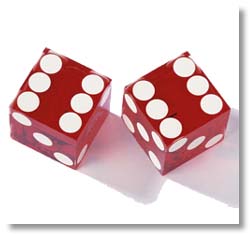
|
| In any sport, reducing the element of chance in the outcome is recognized as the primary goal of organized competition. |
Let's anticipate, somewhat, the discussion that might follow from this proposal (and which is invited from you, the readers, through the Readers Forum). It would be mostly about the management virtues of "tight scheduling" and spectator values. The critics will say that spectators want to know when the final game or match will be played.
These are legitimate considerations - small ones, in my opinion. The abundance of time and courtspace for this national championship at such facilities as the National Croquet Center (and in 2009, at Mission Hills in California) would surely allow for this small adjustment to assure Perfect Justice in the design of the tournament. And remember: this all happens on the FINAL DAY, when most of the courts are standing empty anyway. As for the spectators, the quality of the final games is likely to very high, and they'll have a chance to see more than one such "final" game.
Compare the tight scheduling of tournaments in America with the typically untimed games (in the top division) in other countries, where schedule uncertainties easily multiply out of control, even when court conditions are easy and weather doesn't delay play. This is an easy fix in American Rules tournaments.
Amendment Two:
Timeless American Rules games to the peg
I hesitate to bring up the other most essential factor in assuring Perfect Justice in American Rules tournaments, because I have heard in the past the outcry about this proposal. Nevertheless, I can envision a time when tournament directors of major American Rules events adopt some of the standards of top-level Association Laws play with regard to TIME. Both versions of the game are actually designed to go to the peg - that is, not to end until one player amasses 26 points. The main reason time is imposed in the 26-point game, as I see it, is to serve the practical constraints of scheduling and court space.
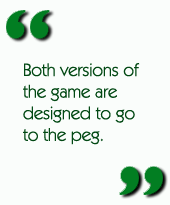
I maintain that the American Rules game is "naturally" shorter in duration at the highest level than Association Croquet - ESPECIALLY WHEN THE GAMES MUST BE PLAYED TO THE PEG! It is my observation - from the two instances when I event-managed major tournaments with otherwise tight time constraints - that Timeless Games in American Rules actually tend towards speeding up play rather than slowing it down, as there is no longer a reason to employ stalling tactics. And stalling strategy is amazingly prevalent in American Rules timed games, even at top level, with controversial ploys like failing to take one or more balls into the game for the first hour. (I enjoy seeing this done, when it's done well, but it wouldn't upset me to see this tactic significantly devalued in Timeless Games.)
In the high-handicap flights, where the players are not expected to execute all-round breaks, Timeless Games would not be practical. However, the adoption of "Wharred turns" (as they are called in the UK) - allowing two, three or more final rotations - is now allowed in American Rules and would significantly reduce the number of irritating stalling tactics often seen in high-handicap games as the game time approaches. (This innovation has also been successfully tested in major tournaments, by myself and others.) In addition, the 14-point "short game" is now condoned in the USCA rulebook.
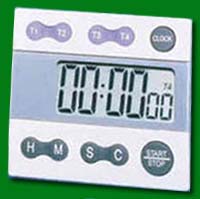
|
| Timeless games to the peg would eliminate stalling tactics in both codes of the game, but especially in American Rules. |
New conditions outweigh outmoded traditions
| Jeff Soo's improved double-elimination draw |
|
In the linked article, Jeff Soo makes a strong case for reducing the incidence of unfair results in pseudo-double-elimination events that simply delete the "if needed" game when the winners of the losers bracket is victorious in his or her one game against the survivor of the winners bracket. He achieves this by reconfiguring the losers bracket. As a bonus, his solution is also more compact, requiring one less time period to complete than the standard version. Soo is skeptical of the possibility of a "comeback" of the true double-elimination format in major events designed, above all, to guarantee the certainty of a single final game at a programmed time. His revised draw, which stands up under computer analysis of likely outcomes, does not guarantee absolute justice, but it may be the best practical solution available to managers determined to pre-announce the time of their single-game final.
|
I'm confident that someday both of these improvements will be widely seen in advanced American Rules tournament play. That's easy to envision, simply from looking at the vast improvements made in tournament play over the 30-year course of the evolution of the American game. There is no need to be stuck in traditions of the past that were generated by a scarcity of court space and the attendant time constraints, along with a much lower level of expertise in the top flights.
Why wait for "someday" when we can create it today? I'd very much like to see either or both of these innovations applied to major tournaments. Tell us (or tell our Readers Forum):Why not? Tell us also: What other improvements do you see coming in the game as an evolutionary function of more and better courts and the improving skill level of the top players?
JUST FORMATS IN ASSOCIATION CROQUET
by Louis Nel
I'm taking the risk of stirring up a hornet's nest in the hope that it will eventually lead to improved formatting for Association Croquet tournaments in North America. I consider a format to be just if it gives players the kind of winning chance they deserve according to their performance level.
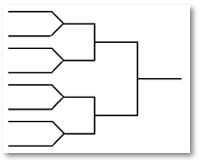
|
| Both the implicit fairness and the drama of the elimination ladder argue for its wide use in many sports, but in the amateur sport of croquet, elimination is usually combined with another format to guarantee players "enough games." |
Top-level formats
"Top level" refers to players that aspire to play in the World Championships or other world class events. Ideal formats for such players may differ significantly from what would be suitable at other levels.
The Round Robin (all play all) treats all players in the same way and is therefore visibly just - at least as a stand-alone format - but it does not always produce a winner. In some situations this is no big deal. For example, if players are tied in the Selector's Eights (i.e. after the 14 games of a double Round Robin) they have effectively shown themselves to perform equally. Since there is no title or trophy, the honor could just as well be shared, could it not?
However, in a national championship there must be a single winner. This calls for a format that inevitably will produce that winner - the Knock-Out (elimination) ladder. But is it a just format? Not necessarily. It will be just if it is a Regulation Seeded Knock-Out (RSKO); that is, if it is seeded in accordance with the relevant WCF Sports Regulation. This seeding is explained in full in the Appendix below.
Seeding according to the Standard Draw is a special case of an RSKO, while seeding as in the Process half of a Standard Draw and Process format is not (see the Appendix for a reminder of how Process seeding works).
Historic example. The Knock-Out stage of the 2002 World Championship was seeded by the latter (Process) method -- this was before the current WCF regulation was introduced. The top seed (Reg Bamford) had an 88% probability of reaching round 3, which he eventually failed to reach after his opponent (Toby Garrison) hit Tea Lady shots in each of the second and third games. Had RSKO seeding been used he would have had a 95% probability of reaching round 3. Nobody knows what would have happened, but the above percentages do illustrate the difference in probabilities that can arise from two different seeding methods.
A best-of-three Knock-Out is significantly more just than a single-game KO. This assertion is numerically verifiable and generally well understood. Prestigious events invariably employ best-of-three matches and, from the semi-final on, even the still better best-of-five.
In a Knock-Out format, half the players are eliminated after each full round, so it cannot provide "enough action" for all players. That is why Knock-Outs are virtually never used as the sole format. Blocks-to-KO (that is, preliminary Round Robins serving as qualifying subtournaments for the Knock-Out) is the most popular choice in North America.
The question arises: should the KO be seeded according to the block results or by following the World Ranking? The first is based on a small number of games, therefore subject to considerable randomness, which could lead effectively to serious deviation from Regulation Seeding. World ranking provides a more reliable indication of playing strength, therefore more reliable seeding. So, in pursuit of justice, I'm putting forward the following (contrary to current North American practice but in line with World Championship regulation):
Suggestion 1. That where blocks are used to qualify for a Knock-Out stage, seeding of the KO be based on World Ranking rather than the block results.
In the determination of who qualifies, tiebreaking becomes an issue. In the 2008 National Championship, net points were used. This is unbecoming. In top level Association Croquet a score of 26 - 0 means something very different from what it would mean in lower flights. Accordingly, net points is widely regarded as an inappropriate performance guage in top level play. Net points as tie-breaker could also be corruptive in the sense of inducing a player to adopt an abnormal line of play. If a player realizes before his last block game that 13 points (win or lose) will secure a play-off berth, that player may well decide to take his first break all the way to the peg - an abnormal line of play. This leads to the following.
Suggestion 2. That net points not be used as a tiebreaker.
What method should be used instead of net points? There is the obvious alternative of play-off games. That comes at the cost of time (in the case of the World Championship the whole tournament comes to a standstill for a whole day for the sake of a small handful of play-off games). There is, however, a much simpler alternative.
Suggestion 3. That block ties be broken in favor of the bottom-ranked player in the tie.
For example, if tied players A, B, and C in a block of 10 are seeded in positions 4, 5 and 6 then the tie is broken in favor of player C with rank 6. Why? Because he performed better in block play than the other two: he had to overcome stronger opposition than the other two in order to get into the tie.
This tie-breaking results when the Event Performance Grade (EPG) method, explained in my article "Who should qualify for the Knock-Out?" (see www.oxfordcroquet.com/tech/nel-wko/index.asp), is applied to a tie in a single block. EPG, based on weighting wins and losses according to win probabilities, was invented to address the injustice that results from block-by-block promotion rather than across-all-blocks promotion when many blocks are present. It was used to good effect in the 2008 Australian Open, where they had to promote 32 players from 6 blocks. In the small tournaments of North America we don't have a "many blocks" problem.
When a tie has to be broken in order to decide who advances, the players in question normally have close to equal chances. So no tie-breaking method will differ much from the effect of a coin-toss. Having a single rational method that always works would be a boon to players and tournament managers alike. I have heard the counter argument that it is inappropriate to give such an important role to ranking. Yet ranking is given a much more profound role in seeding of the KO of the World Championship. So why not use it for the relatively minor purpose of deciding who sneaks in at the bottom of a KO?
It is important that all tie-breaking procedures be announced before play begins. If a new method is being introduced, it should be announced when entries are invited. Announcement of the procedure of Suggestion 3 gives an implicit message to each player: if you want to advance into the KO, be sure to beat enough rivals - don't base your hope on net points or another second chance; go all-out for the win!
In the interests of justice, tie-breaking is best avoided altogether, whenever that is possible in the format design.
My preferred format for a National Championship is two days of (mainly) doubles followed by 4 days of (mainly) singles. A Seeded Draw and Process would work for the doubles. Singles would be best-of-three RSKO, without time limit, with a concurrent Flexible Swiss as the consolation event.
This format is clearly just. Additionally, the "enough action" weakness of the KO format would be mitigated by the doubles and the concurrent Flexible Swiss. It produces a clear winner without any tie-breaking in the main events. In other words, the singles championship is to be modeled on the excellent example of the North Carolina Open (except that the seeding method used there has not been quite RSKO). The North Carolina Open, sometimes oversubscribed, has shown that this format is not only feasible but also well-received by the players.
There are several venues that could accommodate at least 24 players. In recent national championships this number has seldom if ever been exceeded. If necessary, the enrollment could fairly be restricted to 24.
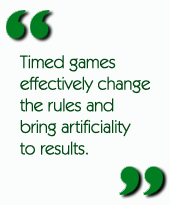
Timed games jeopardize justice. The game is designed to finish at the peg. Short games (timed to a maximum of 2 hours, for example) effectively change the rules and bring artificiality to results. Aside from justice considerations, double banking and slow opponents are less annoying when time is not a critical factor.
Variations that jeopardize justice should be avoided where possible. Here are some examples.
Example 1. The 2008 U.S. Open had 2 blocks of 9 plus an additional cross-block game as follows: Seed 1 of block A vs Seed 1 of block B, Seed 2 of block A vs Seed 2 of block B etc. These cross-block games created an unlevel playing field.
Example 2. The 2008 North American Open had 1 block of 16 followed by play-offs. The winner of the Round Robin went straight to the best-of-three final. Positions 2 and 3 played off (best-of-three) for the other final berth. So the block winner had to sit and get cold waiting for an opponent. Why was the other finalist not the winner of 1 vs 4, played concurrently with 2 vs 3? Recently Jonathan Kirby, the 2007 winner, told the Nottingham Board that he was tempted (but could not bring himself) to throw his last block game in order to avoid this unfavorable situation for the block winner.
The tournaments of the two examples above have been great events for several years. It is a pity that such bad formatting decisions have detracted from their excellence.
Strictly speaking, the blocks-to-KO format is by itself a variation that jeopardizes justice. It may tempt top players to manipulate the outcome. For example, a top player, after securing play-off access for himself, may in a remaining "dead" game deliberately lose to a weaker player if the latter is a friend or if this could cause the weaker player to advance into the KO at the expense of a stronger player. This bad side-effect of the blocks-before-KO format is well known (it entered the discussions recently of two WCF committees on which I'm serving). Ironically enough, the world championship is one of the more likely events in which such misbehavior may occur.
I would welcome a law which says explicitly that a player must never lose a game deliberately. It may be difficult or impossible to enforce, but it will at least mobilize the force of public opinion against players who consider employing such "gamesmanship." At present, healthy formatting is the only effective guard against this unjustly manipulative behavior. That is another reason why RSKO is my format of choice for a prestigious championship. Of course, it must be supplemented by doubles and/or a well-run consolation event to guarantee "enough action" for all the entrants.
Lower flight formats
Some of the above does not apply to lower flights. Games without time limit would be both unpractical and unwelcome for beginners. For players who seldom if ever play a complete break, a 2-hour time limit is quite adequate and for such players net points provide a reasonable tie-breaking criterion. Longer game times become relevant when complete breaks are frequently played and a reasonable prospect arises for the game to finish at the peg. A game time of 2 hours 15 minutes already increases noticeably the percentage of completed games, but longer than that is preferable whenever possible. In other countries a conventional game-time limit is three hours.
The alternative of 14-point games without time limit would work for break-playing competitors but not for beginners (who would still take well over 3 hours to peg out). While 14 point games make a lot of theoretical sense, players generally prefer the "real" game. I have noticed a similar reaction against smaller courts. In the Ottawa Open I once put the A flight on a 7/8 court. A survey after the tournament revealed that they would have preferred traveling to a nearby club in order to play on full-size courts only, even when the surface of the nearby court was inferior. Ever since, the Ottawa Open has been played on full courts only. Sometimes emotion must trump logic.
|
Appendix: The STANDARD DRAW uses the following pairings in the first round.
1 vs 32 16 vs 17 8 vs 25 9 vs 24
The likely second round pairings are
1 vs 16 8 vs 9 5 vs 12 4 vs 13
The likely third round (quarter final) pairings are
1 vs 8 5 vs 4 3 vs 6 2 vs 7, The likely semifinal pairings are 1 vs 4, 2 vs 3.
The WCF REGULATION DRAW (RSKO) The first round opponents of players 1 through 8 are randomly selected from the set of first round opponents of these players in the Standard Draw, i.e. from players 25 through 32; The first round opponents of players 9 through 16 are randomly selected from the first round opponents of these players in the Standard Draw, i.e. from the players 17 through 24. The likely second round opponents of players 1,2,3,4 are randomly selected from the likely opponents of these players in the Standard Draw, i.e. players 13, 14,15,16; The likely second round opponents of players 5,6,7,8 are randomly selected from the likely opponents of these players in the Standard Draw, i.e. players 9,10,11,12. The likely quarter final pairings and semifinal pairings are like that of the Standard Draw. Random selections are used to prevent players jockeying for position by deliberately losing games. The PROCESS seeding uses the following pairings in the first round
1 vs 17 9 vs 25 5 vs 21 13 vs 29
The likely second round pairings are
The likely quarter final pairings are The likely semifinal pairings are 1 vs 3, 2 vs 4. When the number of entrants is a smaller power of 2 (e.g. 16, or 8) then the likely pairings listed above become the actual pairings of the first round. When it is not a power of 2, one merely fills it up with dummy players, named "bye" ranked below the real players, until it is a power of 2, and then proceed as above.
|
A NOTE ON THE AUTHOR: Louis Nel is a regular player in North American Association Croquet tournaments, chairman of the World Croquet Federation Seeding Method Committee, member of the WCF Ranking Review Committee, and a retired professor of mathematics.